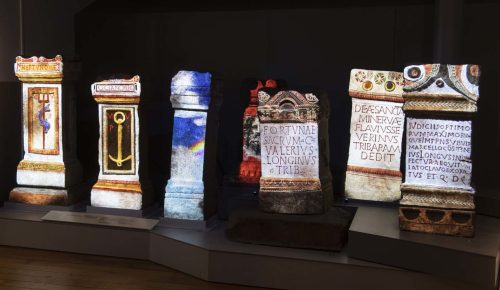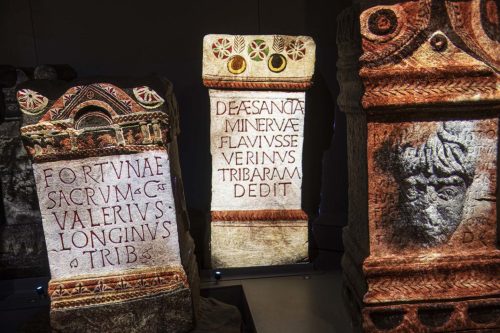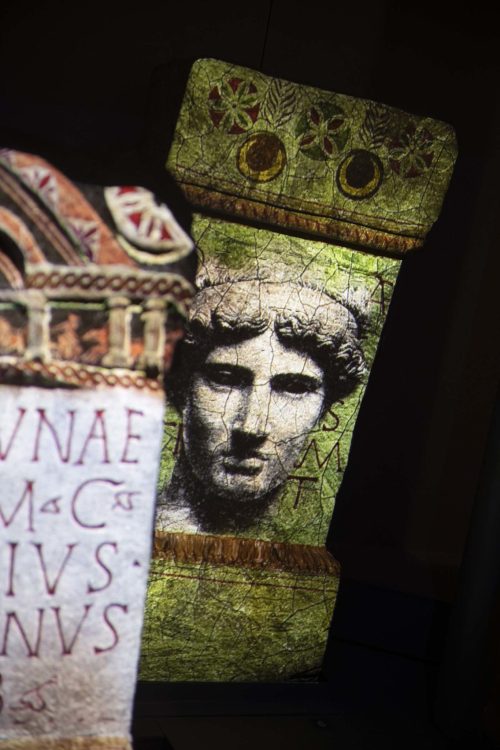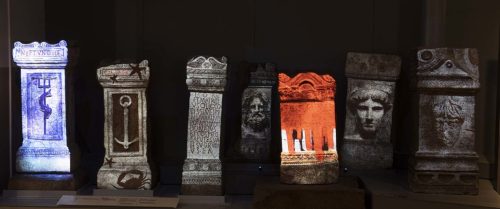blueiskewl:Roman Altars Reveal Their True Colors Seven Roman altars at the Great North Museum: Hanco
blueiskewl:Roman Altars Reveal Their True Colors Seven Roman altars at the Great North Museum: Hancock now feature animations projected directly onto the stone surfaceHistorians often tell us to try and visualize the past as a colorful place – whether it be the bright colors of medieval clothing and statuary or the vibrant blues and golds found in the tombs of Antiquity.Accordingly Roman Britain was also a place of vibrant hues – even at its most northern reaches. Apart from the deep red robes of the Roman legions, Pliny the Elder cited the orange, red and purple worn by priests and priestesses, while common dyes used in the Roman world included madder, kermes, weld, woad, saffron and lichen purple. But these colors weren’t just confined to robes and other clothing, the statues and buildings also offered a surprising palette – as can be glimpsed in a new project at the Hancock in Newcastle, which is revealing the colors encountered along Rome’s Northern frontier at Hadrian’s Wall.The Museum has a vast collection of altars recovered from Hadrian’s Wall – many of them with dedications to the deceased and inscriptions to the Roman Gods – and seven of the latter now feature animations projected directly onto the stone surface to offer a sense of how brightly colored the altars appeared 1900 years ago.The project, called Roman Britain in Color, is a collaboration between the Museum and Hadrian’s Wall Community Archaeology Project (WallCAP), working alongside creative studio NOVAK.“We’re used to the look of sandstone altars and reliefs in museums but we forget that they were originally painted in bright colors,” says Andrew Parkin, the Museum’s Keeper of Archaeology. “The paint has been lost over the centuries but researchers have found trace amounts of pigment using ultraviolet light and x-rays.“These new projected animations really make the altars stand out and add greatly to the Hadrian’s Wall gallery in the museum. The team at NOVAK have done a fantastic job in creating the artwork and mapping the projections precisely onto the stones.”The animations also offer some artistic interpretations of the altars and the gods associated with them. For instance, the altar to Neptune, Roman god of freshwaters and rivers, was found in the River Tyne. It depicts a blue underwater scene filled with fish.The altar to Oceanus, god of the sea, is animated with seaweed, starfish and a crab, whereas the altar to Fortuna drips with bright crimson, perhaps suggesting a ritual using wine or the blood of a sacrificed animal.Other altars with new animations are dedicated to Jupiter, supreme deity of the Roman pantheon, Minerva, goddess of wisdom and strategic warfare, and Antenociticus, a native British god only found at Condercum Roman Fort – present-day Benwell in the west end of Newcastle.“Roman altars are a great source for understanding the culture of the Roman Empire, but they can seem boring and uninteresting for people that do not know how to ‘read’ them,” adds Dr Rob Collins, Senior Lecturer in Archaeology and WallCAP Project Manager at Newcastle University.“Working with NOVAK and the Great North Museum: Hancock, the altars come alive and invite you to look more closely at the artistry and information that they hold.”Anyone interested in volunteering for the WallCAP project can register at wallcap.ncl.ac.uk. Volunteers receive regular updates to alert them of forthcoming opportunities and events to investigate and protect the Wall.By Richard Moss. -- source link




